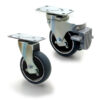
Online retail is so strong that traditional retailers are starting to feel the pressure and are starting to change their business model. And, indeed, as statistics (which you can click here to read) suggest, eCommerce is only continuing to grow, especially now that so many of us own a smartphone that enables us to research, compare, and buy products without even having to turn on a computer. For small businesses, one benefit of online stores is the ability to sell to people far beyond those who would otherwise walk into your business. Many are intimidated and don’t think they have the expertise to start an online store. However, opening an online store on a low budget is possible and relatively easy if you get a loan.
Determine What You’re Going to Sell
When you’re planning on going into business, one of the first things you want to decide is what you’re going to sell, as this will determine the size of the business loan you will need. If you’re going to sell memberships to premium content and sell some branded swag as a side benefit to support your blog, your needs are very different from a website that’s going to make eBooks or print books available. The business model is different yet again if you want to sell specific items to the public. While some eCommerce platforms work very well for physical products, they might not be as suited for digital ones, so be aware of that before you start. If you are focused on selling physical products, there is a lot more that goes into the production of these items as not only do you have to think about the style of the product but the packaging as well. Using companies such as Impacked Packaging can equip you with the appropriate packaging you need, or you could look into designing your own depending on your budget and needs. It can be daunting to start your own business, but ticking all the boxes at the start will provide you with a smoother operation
If you’re going to sell digital content, you could set up an online store by going through an existing digital marketplace like Amazon or Barnes and Noble. You don’t have to set up a website but instead rely on their website and content delivery system. All you need to do is focus on creating your product pages within their platform and optimizing them. Then you can focus on promoting them while letting someone else handle the technical details.
If you’re selling a physical product, you could set up a shopping cart on your own website. This requires accepting payment and shipping items yourself. The main attractions of this business model are that you control the process entirely, don’t have to follow anyone else’s rules and restrictions, and you don’t have to pay anyone else a commission. You may need to pay someone else to create the product pages and shopping cart modules on your site, but once completed, you can run it on your own.
You could partner with a service that stocks your item and ships it when the orders are received. You need to vet these services carefully however, since they may take your inventory and sell it themselves if unscrupulous, and be slow to ship even if legitimate. The main attraction of this business model is that you don’t have to handle orders at all and can leave the business on automatic except to check on customer reviews and complaints.
Or you could create a store on existing online marketplaces. This a low-cost way to start an online store. The benefit of this approach is that you don’t need to create a separate website, since these marketplaces provide templates and financial system interfaces. The downside is that you have to follow their rules to sell on the platform; they also take a percentage of the sale price for this service. However, there’s no upfront cost, either, as you would pay when hiring a website developer to integrate ecommerce into your existing website.
Once you’ve picked a product or service and the business model that suits it, you’ll need to set up your online store. If you’re going through an online marketplace, you’ll be able to set up a basic “store” using their templates. These will often be free up to a certain number of items, so you could take advantage of these trial offers.
You may want to pay someone else to apply search engine optimization to your product pages, upload hundreds of products or add interactive content where allowed. If you are putting ecommerce functionality on your existing site, you could use existing third-party code modules on your site to do it instead of hiring a web developer. If you’re going to use a drop shipper or warehouse site to fulfil your orders, you simply need to update your website to tell people how to place an order.
So, if you want to start an online store, first determine what you’re going to sell since this affects the best business model you should use to deliver it to your customers. Once you’ve picked a business model, you either alter your website to direct people to the third-party hosted online store or integrate ecommerce into your existing website.










